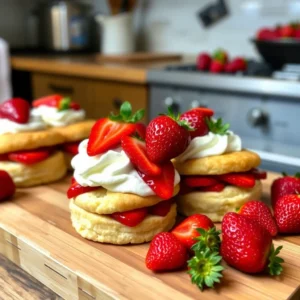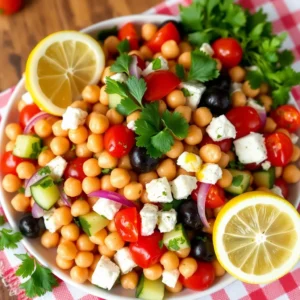Why You’ll Love These Roasted Vegetable and Quinoa Power Bowls
Let me tell you, there’s nothing quite like the satisfaction of a well-assembled roasted vegetable bowl. I’m talking about that perfect balance of nutty quinoa, caramelized vegetables, and a sauce that ties everything together like the final brushstroke on a masterpiece. These power bowls aren’t just another meal—they’re your secret weapon for those days when life feels like it’s moving at warp speed.
As a busy home cook myself, I understand the struggle of wanting to feed your family something nutritious without spending hours in the kitchen. That’s exactly why these quinoa power bowls have become a regular fixture in my household. You can prep most components ahead of time (hello, Sunday meal prep!) and assemble them throughout the week for lunches that’ll make your coworkers green with envy.
What I love most about these bowls is their versatility. Got picky eaters at home? Let everyone build their own bowl with their preferred veggies. Trying to use up whatever’s left in your fridge before grocery day? These bowls are basically a delicious strategy for reducing food waste. The roasting process transforms even the most humble vegetables into caramelized nuggets of goodness that’ll have everyone reaching for seconds.
There’s something magical about the way roasting concentrates the flavors of vegetables. That sweet spot when the edges turn golden brown and slightly crispy? That’s culinary gold right there. Combined with protein-packed quinoa and a zingy dressing, these bowls deliver satisfaction that lasts far longer than the drive-thru fix you might be tempted to grab on busy days.
For those of you trying to eat more plant-based meals without feeling deprived, these roasted vegetable bowls hit the sweet spot. They’re substantial enough to please even the dedicated meat-eaters in your life while being completely customizable for vegetarians and vegans. Plus, they’re naturally gluten-free, which is a lifesaver if you’re navigating food sensitivities or allergies in your household.
The rainbow of colors in these bowls isn’t just Instagram-worthy—it’s nutrition at its finest. Each color represents different vitamins and antioxidants, so when you’re crunching into that medley of roasted veggies, you’re essentially giving your body a comprehensive wellness package. And unlike those salads that leave you hunting for a snack an hour later, these power bowls keep you fueled through afternoon meetings, kids’ activities, or whatever else your day throws your way.
If you’ve been stuck in a lunch rut (turkey sandwich, anyone?), consider these bowls your ticket to freedom. They travel well, taste amazing at room temperature, and won’t leave your desk or break room smelling like last night’s fish dinner—a courtesy your coworkers will definitely appreciate!
The Story Behind These Roasted Vegetable and Quinoa Power Bowls
These quinoa power bowls were born on what I like to call a “refrigerator intervention day.” You know the kind—when you open your produce drawer and realize you’ve been a bit overzealous at the farmers market. Again. There were bell peppers starting to wrinkle, an eggplant giving me the side-eye, and zucchini that wouldn’t last another day.
My usual “rescue mission” would have been a big pot of soup, but it was the middle of summer, and the thought of standing over a steaming pot while the kitchen turned into a sauna wasn’t appealing. That’s when inspiration struck. I cranked up the oven (counterintuitive in summer, I know, but trust me), tossed everything with olive oil and spices, and let the magic happen.
While the vegetables were transforming in the oven, I remembered the container of quinoa sitting in my pantry—one of those health food purchases that had good intentions written all over it but hadn’t seen the light of day in weeks. As the nutty aroma of quinoa filled the kitchen, mixing with the scent of roasting vegetables, I knew I was onto something special.
My kids, who typically approach vegetables with the enthusiasm of a cat facing a bath, wandered into the kitchen asking what smelled so good. That’s when I knew this wasn’t just dinner—it was the beginning of a family favorite. When my pickiest eater actually asked for seconds of what was essentially a big bowl of vegetables, I nearly fell off my chair!
Since that fateful day, these roasted vegetable bowls have become somewhat legendary in our house and among friends. When my neighbor was recovering from surgery, these were the first meals I packed up for her family. Her husband—a self-proclaimed carnivore—called to ask for the recipe, which in my book counts as a culinary miracle.
I’ve made these bowls for potlucks, packed them for picnics at the park, and assembled them on those nights when everyone’s eating at different times due to sports practices and homework sessions. They’ve fueled us through home renovations, deadline crunches, and those busy seasons of life when cooking elaborate meals just isn’t in the cards.
What I love most is watching how these bowls evolve with the seasons. In summer, they’re bright with bell peppers, zucchini, and fresh herbs from the garden. Come fall, they transform with hearty root vegetables and warming spices. They’re like the chameleon of meals—always recognizable but never exactly the same twice.
If you’re looking for more seasonal inspiration, you might enjoy my Incredible 30-Minute Vegetable Soup, which follows a similar philosophy of making vegetables the star of the show.
As you make these bowls your own, remember that the recipe is more of a template than a strict set of rules. The joy is in the creating—and of course, in the eating!
Part 1 complete. Type ‘Continue’ for Part 2.
Ingredients
For a roasted vegetable bowl that sings with flavor, quality ingredients make all the difference. Here’s everything you’ll need to bring these quinoa power bowls to life:
For the Quinoa Base:
- 1 cup uncooked quinoa (white, red, or tri-color all work beautifully)
- 2 cups vegetable broth (or water, but broth adds an extra dimension of flavor)
- 1 bay leaf (optional, but adds a subtle depth)
- ¼ teaspoon salt (if using water instead of broth)
Quinoa is truly the unsung hero of these bowls. This tiny seed (yes, it’s technically a seed, not a grain!) packs a serious protein punch while providing a subtly nutty flavor and delightful texture. If you’re new to quinoa, know that it’s incredibly forgiving to cook and absorbs whatever flavors you pair it with—making it the perfect canvas for our roasted vegetables.
For the Roasted Vegetables:
- 1 medium zucchini, cut into ½-inch half-moons
- 1 red bell pepper, seeded and cut into 1-inch pieces
- 1 yellow bell pepper, seeded and cut into 1-inch pieces
- 1 medium eggplant, cut into 1-inch cubes
- 1 red onion, cut into 1-inch wedges
- 2 cups cherry tomatoes, halved
- 3 tablespoons olive oil
- 3 cloves garlic, minced
- 1 teaspoon dried oregano
- 1 teaspoon dried thyme
- 1 teaspoon ground cumin
- ½ teaspoon smoked paprika
- Salt and freshly ground black pepper, to taste
Feel free to substitute any vegetables you have on hand. Sweet potatoes, carrots, broccoli, cauliflower, and Brussels sprouts all roast beautifully. The key is cutting everything into similar-sized pieces so they cook evenly. If you’re short on time, many grocery stores now offer pre-cut vegetables in their produce section—a little more expensive but sometimes worth the convenience on busy weeknights.
For the Lemon-Tahini Dressing:
- 3 tablespoons tahini (sesame seed paste)
- 2 tablespoons fresh lemon juice
- 1 clove garlic, finely minced or grated
- 2-3 tablespoons water, or as needed for consistency
- 1 tablespoon extra-virgin olive oil
- 1 teaspoon honey or maple syrup (for vegan option)
- ¼ teaspoon ground cumin
- Salt and freshly ground black pepper, to taste
If tahini isn’t your thing or you don’t have it on hand, don’t worry! These bowls are equally delicious with a simple balsamic vinaigrette, a spoonful of hummus, or even a drizzle of good olive oil and lemon juice. The dressing should complement, not overpower, those beautiful roasted vegetables.
For Assembly and Garnish:
- 1 avocado, sliced
- ¼ cup mixed fresh herbs (such as parsley, cilantro, mint, or basil), chopped
- ¼ cup toasted pumpkin seeds or sunflower seeds
- Lemon wedges for serving
- Optional protein add-ins: chickpeas, black beans, crumbled feta, grilled chicken, or baked tofu
Garnishes aren’t just pretty—they add crucial textural contrast and bright flavors that elevate these bowls from good to can’t-stop-eating good. The creamy avocado, crunchy seeds, and fresh herbs bring everything together in harmony.
If you’re looking to keep your pantry stocked for bowls like these, I recommend checking out this comprehensive guide to building a well-balanced pantry from Bon Appétit, which covers all the essentials you’ll want on hand.
Execution
Creating the perfect roasted vegetable bowl is all about timing and technique. Follow these steps and you’ll have a restaurant-worthy meal that’s both nourishing and deeply satisfying:
Step 1: Prepare the Quinoa
- Rinse 1 cup quinoa in a fine-mesh sieve under cold water for about 30 seconds. This removes the natural saponin coating, which can give quinoa a bitter taste.
- In a medium saucepan, bring 2 cups vegetable broth (or water plus ¼ teaspoon salt) to a boil.
- Add the rinsed quinoa and bay leaf if using. Reduce heat to low, cover, and simmer for about 15 minutes, or until all liquid is absorbed.
- Remove from heat and let sit, covered, for 5 minutes. Then fluff with a fork and set aside. The quinoa should be tender but still have a slight bite to it.
Step 2: Roast the Vegetables
- Preheat your oven to 425°F (220°C) and line two large baking sheets with parchment paper for easy cleanup.
- In a large bowl, toss all prepared vegetables (zucchini, bell peppers, eggplant, red onion, and cherry tomatoes) with olive oil, minced garlic, dried oregano, thyme, cumin, smoked paprika, salt, and pepper.
- Spread the vegetables in a single layer across the baking sheets. Don’t overcrowd them—this is the secret to getting that beautiful caramelization instead of steamed vegetables.
- Roast for 25-30 minutes, rotating the pans halfway through and giving everything a good stir to ensure even browning. You’re looking for tender vegetables with golden, slightly crispy edges.
Step 3: Make the Lemon-Tahini Dressing
- While the vegetables are roasting, whisk together tahini, lemon juice, minced garlic, olive oil, honey or maple syrup, and cumin in a small bowl.
- Add water one tablespoon at a time, whisking after each addition until you reach your desired consistency—it should be pourable but not watery.
- Season with salt and pepper to taste. If it’s too thick after refrigeration, simply whisk in a splash of water before serving.
Step 4: Toast the Seeds
- In a small dry skillet over medium heat, toast pumpkin or sunflower seeds until fragrant and lightly golden, about 3-5 minutes. Keep a close eye on them as they can burn quickly!
- Remove from heat and let cool. They’ll add a wonderful crunch to your finished bowls.
Step 5: Assemble Your Bowls
- Start with a base of warm quinoa in each bowl (about ½-¾ cup per serving).
- Arrange a generous portion of roasted vegetables on top.
- Add any protein add-ins you’re using (chickpeas, beans, feta, chicken, or tofu).
- Fan out slices of avocado on top.
- Drizzle with the lemon-tahini dressing—be generous here!
- Scatter fresh herbs and toasted seeds over everything.
- Serve with lemon wedges on the side for an extra brightness boost.
For an extra flavor dimension, try adding a sprinkle of homemade taco seasoning to your vegetables before roasting. It adds a wonderful depth that complements the other flavors perfectly.
The beauty of these quinoa power bowls is that they’re incredibly adaptable. If you’re meal prepping, keep the components separate and assemble just before eating. The roasted vegetables and quinoa will keep well in the refrigerator for 3-4 days, making weekday lunches a breeze.
Remember, the goal is vibrant flavors and varied textures in every bite. As you assemble your bowl, think about creating a balance—something creamy (avocado), something crunchy (seeds), something tangy (dressing), and plenty of those caramelized roasted vegetables as the star of the show.
Part 2 complete. Type ‘Continue’ for Part 3 + Meta Description.
Additional Tips
Mastering the art of the perfect roasted vegetable bowl goes beyond just following a recipe. Here are some game-changing tips that will elevate your quinoa power bowls from good to absolutely unforgettable:
Perfect Your Roasting Technique: Don’t rush the roasting process—those caramelized edges are where the magic happens! If your vegetables aren’t developing enough color, check that your oven is properly preheated and that you’re not overcrowding the pan. Each vegetable piece should have its own personal space to achieve maximum flavor. For vegetables that contain more water (like zucchini and eggplant), try salting them and letting them sit for 15 minutes before roasting—this draws out excess moisture and concentrates their flavor.
Make-Ahead Strategies: These bowls are meal-prep champions! Roast a big batch of vegetables on Sunday, cook your quinoa, and prepare the dressing. Store everything separately in airtight containers in the refrigerator, and you’ll have the building blocks for quick meals all week. Just reheat the quinoa and vegetables slightly (or enjoy them at room temperature) before assembling. The dressing will thicken in the fridge, so whisk in a bit of warm water to reach the right consistency when you’re ready to use it.
Seasonal Variations: One of the joys of this recipe is adapting it through the seasons:
- Spring: Asparagus, snap peas, radishes, and spring onions
- Summer: Zucchini, bell peppers, eggplant, cherry tomatoes, and corn
- Fall: Butternut squash, Brussels sprouts, carrots, and parsnips
- Winter: Sweet potatoes, cauliflower, beets, and hearty greens like kale (toss them in during the last 5 minutes of roasting)
Temperature Matters: While these bowls are often served warm, they’re equally delicious at room temperature, making them perfect for packed lunches or picnics. If you’re taking them to work, pack the avocado separately and slice it just before eating to prevent browning. The same goes for the dressing—keep it separate until you’re ready to eat to maintain the perfect texture of all components.
Batch Cooking Quinoa: Cook a double batch of quinoa and freeze portions in airtight containers or zip-top bags. Thaw overnight in the refrigerator for quick meal assembly. Quinoa maintains its texture beautifully after freezing, unlike some other grains that can become mushy.
Customize Your Protein: These bowls are naturally vegetarian, but they’re endlessly adaptable:
- For vegan protein: Add roasted chickpeas, black beans, or crispy baked tofu
- For omnivores: Top with grilled chicken, salmon, or a soft-boiled egg
- For a Mediterranean twist: Crumble some feta cheese or add a dollop of hummus
Create a Toppings Bar: When serving to family or guests, set up a build-your-own bowl station. Place the quinoa and roasted vegetables in the center, surrounded by bowls of various toppings and the dressing. Everyone can customize their bowl according to their preferences—a strategy that works wonders for families with picky eaters or mixed dietary needs.
Storage Solutions: Leftover components will keep in the refrigerator for 3-4 days. Store the roasted vegetables in a container lined with paper towels to absorb any excess moisture released as they cool. This prevents them from becoming soggy. The tahini dressing will keep for up to a week, though you may need to re-emulsify it with a quick whisk before using.
Troubleshooting Tips:
- If your quinoa is mushy: You likely used too much liquid or overcooked it. Try reducing the cooking time by a few minutes next time.
- If your vegetables aren’t browning: Your oven may not be hot enough, or the vegetables might be too crowded. Try increasing the temperature by 25 degrees or using an additional baking sheet.
- If your tahini dressing is bitter: Some brands of tahini can be more bitter than others. Balance it with a bit more honey or maple syrup, or add a tiny pinch of salt to counteract the bitterness.
For more ideas on keeping your vegetables crispy and delicious, take a peek at my Crispy Air Fryer Chicken Wings recipe, where I share techniques that apply beautifully to all kinds of roasted foods.
FAQs
1. Can I use different grains instead of quinoa in my roasted vegetable bowl?
Absolutely! While quinoa provides excellent protein and a lovely texture, these bowls are wonderfully adaptable. Brown rice, farro, barley, or even cauliflower rice for a lower-carb option all work beautifully. Just adjust cooking times and liquid amounts according to the specific grain you’re using. Remember that heartier grains like farro and barley will give you a chewier texture, while cauliflower rice creates a lighter bowl.
2. How can I make sure my vegetables roast perfectly every time?
The secret to perfectly roasted vegetables lies in three key factors: temperature, space, and size. Always preheat your oven thoroughly (at least 10 minutes at 425°F), give each vegetable piece enough room on the baking sheet (use two sheets if necessary), and cut them into consistent sizes for even cooking. For extra-crispy results, pat the vegetables dry after washing and don’t be afraid of a little extra olive oil—it helps conduct heat and develop those irresistible caramelized edges.
3. My tahini dressing keeps separating. How can I fix this?
Tahini dressing separation is a common issue! The key is emulsification. Start by mixing the tahini with the lemon juice and garlic first, then slowly add the olive oil while whisking continuously. Add water last, one tablespoon at a time, until you reach your desired consistency. If it still separates, don’t worry—a quick whisk or shake before serving will bring it back together. You can also try using a blender or food processor for a more stable emulsion.
4. How can I meal prep these quinoa power bowls for a busy week?
These bowls are meal-prep champions! Roast all your vegetables and cook the quinoa on Sunday, then store them separately in airtight containers. Prepare the dressing and keep it in a jar. Chop hardy herbs like parsley or cilantro and store them in a paper towel-lined container. When you’re ready to eat, warm the quinoa and vegetables slightly (or enjoy them at room temperature), slice fresh avocado, assemble your bowl, and add the dressing. Everything except the avocado and tender herbs will keep for 3-4 days in the refrigerator.
5. Are these bowls suitable for special diets?
These roasted vegetable and quinoa power bowls are naturally gluten-free, vegetarian, and can easily be made vegan by using maple syrup instead of honey in the dressing. They’re also dairy-free unless you add cheese as a topping. For paleo or low-carb diets, substitute the quinoa with cauliflower rice and ensure your tahini is free from additives. If you’re watching sodium, control the amount of salt you add and consider using low-sodium vegetable broth.
6. What’s the best way to reheat leftover components without making them mushy?
To reheat quinoa, add a splash of water or broth, cover, and warm gently in the microwave or on the stovetop. For the vegetables, the oven is your friend—spread them on a baking sheet and heat at 350°F for about 5 minutes until just warmed through. Avoid overheating, which can make them soft. Alternatively, room temperature components often taste great together, especially in warmer months! The dressing should not be heated—just bring it to room temperature and whisk before using.
7. Can I freeze roasted vegetables for future bowls?
While you can freeze roasted vegetables, they will lose some of their texture upon thawing. If you do freeze them, use them in applications where the slight texture change won’t matter as much—think soups, sauces, or purées. Quinoa freezes beautifully, however! Portion it into freezer-safe containers or bags, and thaw overnight in the refrigerator when you’re ready to build your bowls.
Creating delicious, health-supporting meals doesn’t have to be complicated or time-consuming. These roasted vegetable bowls combine colorful produce, protein-rich quinoa, and a creamy dressing into a meal that feels like a gift to yourself. Whether you’re cooking for one or feeding a crowd, this recipe adaptable enough to please everyone at your table.
For more versatile recipes that celebrate vegetables in all their glory, check out my Ultimate Vegetable Stir Fry—another weeknight wonder that transforms humble produce into something extraordinary.
Remember, the best recipes are the ones you make your own. Start with this template, then let your creativity and personal taste preferences guide you to create your perfect bowl. Happy cooking!
Roasted vegetable bowl transforms everyday quinoa into a satisfying, nutrient-rich meal ready in under 1 hour. Perfect for busy weeknight dinners or meal prep for healthy lunches!



